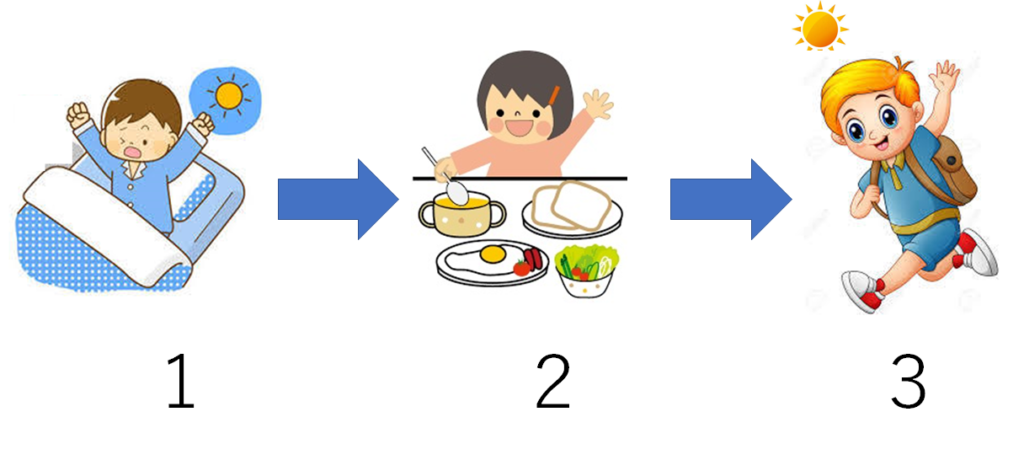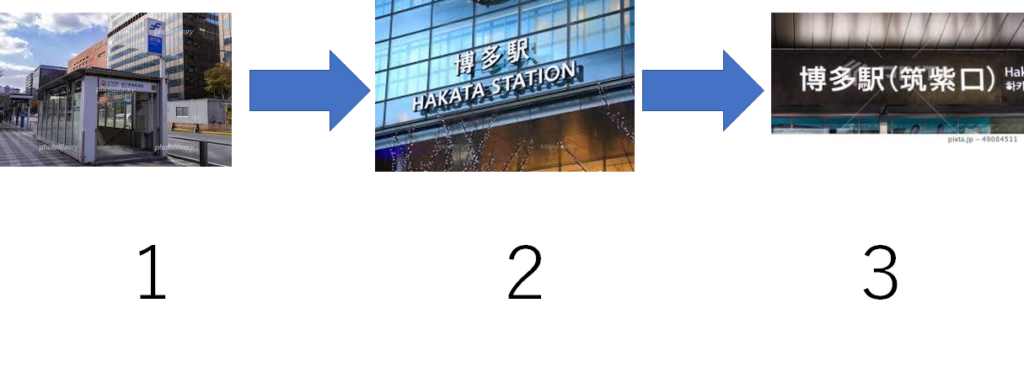
V<て形>、V<て形>~
first V, second V, third V
文型-1
Sentence style-1

朝、何をしますか。 朝、起きます。
What do you do? I get up in the morning.
それから何をしますか。 朝食を食べます。
What do you do then? I have breakfast.
それから何をしますか。 学校へいきます。
What do you do then? I go to school.
「<Vて形>、<Vて形>、~」⇒ first, second, third
朝 起きて、 second 朝食を食べて、 それから third 学校へいきます。
In the morning, first I get up, second have breakfast, then going to school.
例文1
Example-1

日曜日、何を しましたか
What did you do on Sunday?
街へ出て、 喫茶店でお茶をして、 買い物をしました。
I went out to the town, had tea at a coffee shop, then went shopping.
日曜日、何を しましたか
First(1の絵を指しながら) 街へ 出て、Second,(2の絵を指しながら)
First (pointing to the picture 1) I went to the town. Second (pointing to picture 2)
喫茶店で お茶をして Third(3の絵を指しながら)
had tea at a coffee shop, Third (pointing to picture 3)
それから、 買い物をしました。
Then went shopping.
最後の 部分 「しました」で 過去の ことだと わかります。
The last part, “went” tells you that it was in the past.

すみません。 新幹線の 駅まで どうやって 行きますか。
Excuse me, how do I get to the Shinkansen station?

地下鉄に 乗って、 博多駅で降りて、 筑紫口へ 行ってください。
You take the subway, get off at Hakata Station, and go to the Chikushi gate.
絵で導入・絵で練習の目次17
「~て」もいっしょに読みたい。
(V1て形)から、V2
After (V1)ing, V2
文型-2
Sentence style-2

ディナーを 食べました。
We ate dinner.
それから、バーで お酒を 飲みました。
Then I drank alcohol at the bar.
ディナーを 食べてから、 バーで お酒を 飲みました。
After having dinner, we drank alcohol at the bar.
「<V1て形>から、V2」 ⇒ V1 then V2
例文-3
Example-3

今から 何を しますか。
What are you going to do now?
1st・・・ 映画を 見ます。
1st … I will watch the movie.
2nd・・・晩ごはんを 食べます。
2nd… I will eat dinner.
映画を 見てから、 晩ごはんを 食べます。
After watching the movie, I will eat dinner.
絵で導入・絵で練習の目次18
「~てから」もいっしょに読みたい。
N1はN2がAです
N2 of N1 is A
文型-3
Sentence style-3

これは 象です。
This is an elephant.
(鼻を指さして)鼻です。 長いですね。
It’s the nose (pointing to the nose).It’s long.
象は 鼻が 長いです。
The elephant has a long nose.

キリンです。
This is a giraffe.
首が 長いですね。
The neck is long.
キリンは 首が 長いです。
The giraffe has a long neck.
「N1はN2がAです」 ⇒ N1「は」特徴 (feature)N2「が」 A
“N2 of N1 is A” ⇒ N1 “ha” feature N2 “ga” A

ここは 田舎です。
Here is the countryside.
山が あります。
There is a mountain.
川が あります。
There is a river.
空気が おいしいです。
The air is fresh.
田舎は、 自然が 豊かです。
The countryside is rich in nature.
例文-4
Example-4

あの 目が 大きい人は 誰ですか。
Who is that big-eyed lady?
スコットさんです。
She is Scott.
みんなの 人気者です。
She is everyone’s favorite.
あの 目が 大きい人は 誰ですか。
スコットさんは あの 目が 大きい 人です。
Scott is a lady with big eyes.
絵で導入・絵で練習の目次7
「~は~が」もいっしょに読みたい。
N1は(いA)くて、~(なA)/N2で、~
N1 is (IA)kute, ~(Na)/N2de,~
文型-4
Sentence style-4

この お寺は 大きいです。
This temple is big.
この お寺は 高いです。
This temple is high.
この お寺は 大きくて、高いです。
This temple is big and high.
「N1は<いA(い)くて、~<なA> /N2で、~」
”N1 is kute, ~/N2de,~”
⇒ このように 2文をつなぐとき、 い形容詞は 「~いです」を「~くて」に な形容詞/名詞は「~です」を「~で」に変えます。
When connecting two or more sentences adjective changes “-i-desu” to “-ku-te”.na-adjectice and noun change “-desu” to “de”.
絵で導入・絵で練習の目次19
「~くて・~で」もいっしょに読みたい。
例文-5
Example-5

ヨシちゃんの ランドセルは どれですか。
Which is Yoshi-chan’s school bag?
あの 黄緑(い形容詞) ランドセルです。
That yellow-green (I adjective) school bag.
あの 新しい(い形容詞) ランドセルです。
That new (I adjective) school bag.
あの 黄緑で 新しい ランドセルです。
That yellow-green and new school bag.
例文-6
Example-6

ネパールは どんな 国ですか。
What kind of country is Nepal?
陽気な(な形容詞) 国です。
It is a cheerful (na-adjective) country.
愉快な(な形容詞) 国です。
It’s a entertaining (na-adjective) coutry.
陽気で、愉快な 国です。
It’s a cheerful and entertaining country.
例文-7
Example-7

あの 傘を さした人は 誰ですか。
Who is that person holding the umbrella?
ガンテさんです。
She is Gante
ガンテさんは ネパール人(名詞)です。
Gante is a Nepalese (noun).
ガンテさんは 日本語学校の 留学生(名詞)です。
Gante is an international student (noun) at a Japanese language school.
ガンテさんは ネパール人で 日本語学校の 留学生です。
Gante is a Nepalese and an international student at a Japanese language school.
ことばを覚えよう。

漢字の練習をしよう。

文の形を覚えよう

耳で覚えよう。

日本語教師 教師用教案


コメント